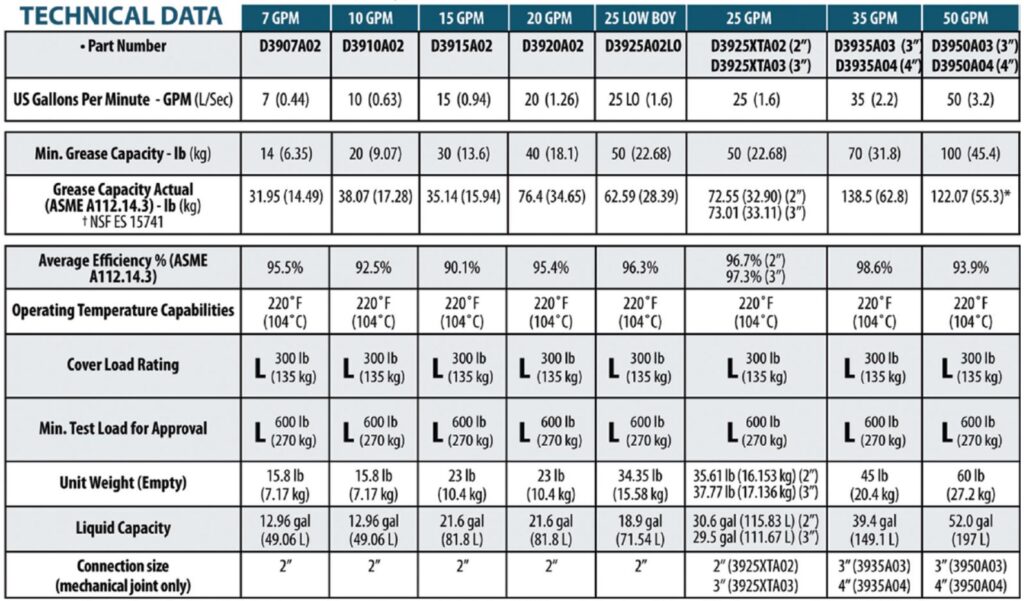
Whether you own a restaurant or commercial kitchen, a grease trap is an essential part of its day-to-day functions. As you prepare food and wash dishes, wastewater makes its way into your drains and plumbing. The grease trap is designed to catch the fats, oils, and greases (or FOG) from the water, keeping it from creating a clog in the line later on. But what size grease trap is right for your business? These guidelines can help you decide.
Why Size Matters
As a business owner, time and money are important considerations in any decision. If you install a grease trap that is too small for your commercial kitchen needs, it could result in frequent overflows and take employees away from their regular duties to clean the mess. You could also find yourself scheduling more frequent pumpings. While erring on the larger side makes sense, choosing a grease trap that is much larger than needed could tighten the budget in other areas.
How to Determine the Right Size Grease Trap
You may be able to find a sizing calculator online, but this is the basic formula for determining the size and capacity of your grease trap.
- Calculate the capacity of your sink by multiplying the length, width, and depth, in inches. If you have multiple compartments or sinks, add the capacity of each sink together to find the total cubic inches.
- Convert the capacity from cubic inches to gallons per minute (GPM) by dividing that number by 231.
- Next, adjust for displacement, which determines the actual useable capacity of your sink, which is usually about 75% of the entire capacity. Multiply your GPM by 0.75 for the GPM Actual Drainage Load.
- If local code requires it, you may need to do the same with your dishwashers, adding this GPM Actual Drainage Load to the number you calculated in Step 3.
- Determine the flow rate and drainage period. For most commercial kitchens, the drainage period is 1 minute, though it could be 2 minutes in certain applications. Divide the number you calculated in Step 3 (or Step 4 if you’ve included dishwashers) and divide it by the drainage period. This number is the flow rate.
- Finally, consult the standard grease trap sizing chart and select the right size grease trap for your unique commercial kitchen. If the flow rate you calculated isn’t listed, round up to the nearest 5.

Other Factors to Consider
Shared Grease Traps
Many restaurants and commercial kitchens actually share a grease trap with other businesses in the building. This is quite common in shopping centers and malls, for instance. If your business will be on a shared grease trap, it’s likely a plumbing expert will survey the businesses and determine the right size grease trap for you and your neighboring businesses to use.
Local Codes and Regulations
Local governments often set their own codes and guidelines for grease trap sizing, though many follow the Uniform Plumbing Code, or UPC. One big factor that local codes dictate is whether dishwashers should be attached to grease traps or not. When dishwashers are attached, you’ll need a larger grease trap to manage water capacity and reduce the risk of overflowing.
What’s Being Made
Grease traps are installed to catch the fats, oils, and greases that end up in a commercial kitchen’s wastewater. However, the amount of FOG that can make it into the wastewater could vary greatly from business to business. For instance, a sub shop will probably produce less grease than a restaurant serving burgers and fries. If your kitchen will be handling more FOG than average, you may want to consider sizing up on your grease trap.
Keeping Your Grease Trap Working Effectively
No matter what size grease trap you install, it will need to be maintained and pumped on a regular basis. If you’re interested in extending the time between pumpings, however, you may want to consider adding a bacteria-based product to your grease trap regularly. Once bacteria are added to the tank, they get to work completely digesting the FOG inside.
BioOne offers an effective bacteria-based liquid product that is safe for use in restaurants and commercial kitchens. You can also purchase a programmable auto-injection system that meters the correct amount of liquid to keep the lines flowing. This allows you to focus on running your business, not pumping your grease trap.
Sizing the Grease Trap for Your Commercial Kitchen
While it’s important to install the right grease trap for your commercial kitchen or restaurant needs, determining the right size can be challenging. Use the formula listed above or use an online calculator to learn the recommended size for your business. Then consider other factors, like whether you’ll be sharing the grease trap with other businesses or if you plan to use more fats, oils, and greases in your cooking. It’s important to consult and follow local codes as well. Once your grease trap is installed, add a bacteria-based product regularly to ensure it runs effectively for years to come.
